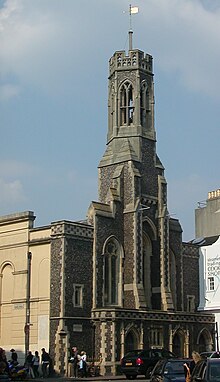Holy Trinity Church, Brighton
| Holy Trinity Church | |
|---|---|

The eastern face of the church
|
|
| 50°49′22″N 0°08′31″W / 50.8228°N 0.1420°WCoordinates: 50°49′22″N 0°08′31″W / 50.8228°N 0.1420°W | |
| Location | Ship Street, Brighton, Brighton and Hove BN1 1AG |
| Country | United Kingdom |
| Denomination | Anglican |
| History | |
| Founded | 1817 |
| Founder(s) | Thomas Read Kemp |
| Dedication | Holy Trinity |
| Consecrated | 1826 |
| Architecture | |
| Status | Chapel of ease |
| Functional status | Art gallery |
| Heritage designation | Grade II listed |
| Designated | 2 March 1981 |
| Architect(s) | George Somers Clarke Jr. |
| Style | Gothic Revival (Perpendicular/Decorated) |
| Closed | 30 October 1984 |
The former Holy Trinity Church is a closed Anglican church in the centre of Brighton, part of the English city of Brighton and Hove. Established in the early 19th century by Thomas Read Kemp, an important figure in Brighton's early political and religious life, it was originally an independent Nonconformist chapel but became an Anglican chapel of ease when Kemp returned to the Church of England. The church closed in 1984, but was converted into a museum and later an art gallery. Reflecting its architectural and historical importance, it has been listed at Grade II since 1981.
Thomas Read Kemp, born in nearby Lewes in 1782, was heavily involved in Brighton's development in the first decades of the 19th century, until he left the country in 1837 to escape his debts. He became the Member of Parliament for Lewes in 1811, but left both the position and the Church of England in 1816 to found an independent Christian sect in Brighton. He moved to the town in 1819, became a major landowner, magistrate, town official and the developer of the high-class Kemp Town estate which still bears his name.
His sect was based at the former St James's Chapel in St James's Street, built between 1810 and 1813. It was intended to serve as a chapel of ease to St Nicholas' Church, but was used by various Nonconformist congregations for its first few years until the Vicar of Brighton found a suitable curate. In 1817, Kemp's uncle Nathaniel bought the church on behalf of the Church of England. At that time, Kemp commissioned Amon Wilds to build a new chapel for him. Situated on the west side of the northern section of Ship Street, which was then a separate entity named Ship Street Lane, it featured a pediment and a square tower, under which was a glass dome which illuminated the interior, and a stuccoed exterior. Although Kemp converted back to Anglicanism in 1823, the chapel remained independent until 1826: a recently ordained priest, Revd Robert Anderson (the brother of the incumbent at St George's Church in Kemp Town) bought it in 1825 and converted it via a private Act of Parliament into a private Anglican chapel. It was consecrated on 21 April 1826 and altered internally; by 1829 its seating capacity was 800.
...
Wikipedia
